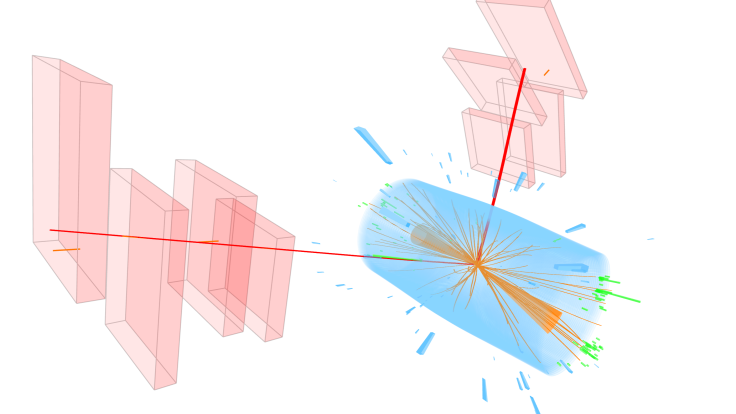There are a lot of things scientists don’t know about dark matter: Can we catch it in a detector? Can we make it in a lab? What kinds of particles is it made of? Is it made of more than one kind of particle? Is it even made of particles at all?
In short, dark matter is still pretty mysterious. The term is really just the name scientists gave to an ingredient that seems to be missing from our understanding of the universe.
But there are some things scientists can definitively say about the stuff.
Natalia Toro is a theoretical physicist at the US Department of Energy’s SLAC National Accelerator Laboratory and a member of the Light Dark Matter Experiment (LDMX) and the Beam Dump Experiment (BDX) dark matter search. She gave a talk at the 2019 meeting of the American Physical Society’s Division of Particles and Fields about the short list of things we do know about dark matter.
1. It’s built to last.
Dark matter formed very early on in the universe’s history. The evidence of this is apparent in the cosmic microwave background, or CMB—the ethereal layer of radiation left over from the universe’s searingly hot first moments.
The fact that so much dark matter still seems to be around some 13.7 billion years later tells us right away that it has a lifetime of at least 1017 seconds (or about 3 billion years), Toro says.
But there is another, more obvious clue that the lifetime of dark matter is much longer than that: We don’t see any evidence of dark matter decay.
The heaviest particles in the Standard Model of particle physics break down, releasing their energy in the form of lighter particles. Dark matter doesn’t seem to do that, Toro says. “Whatever dark matter is made of, it lasts a really long time.”
This property isn’t unheard of—electrons, protons and neutrinos all have extremely long lifespans—but it would be unusual, especially if dark matter turns out to be heavier than those light, stable particles.
“One possibility is that there’s some kind of charge in nature, and dark matter is the lightest thing that carries that charge,” Toro says.
In particle physics, charge must be conserved—meaning it cannot be created or destroyed. Take the decay of a muon, a heavier version of an electron. A muon often decays into a pair of neutrinos, which carry no charge, and an electron, which shares the muon's negative charge. So even though the muon has fallen apart into three other particles, its electromagnetic charge is conserved overall in the results of the decay.
The electron is the lightest particle with a negative electromagnetic charge. Since there’s nothing with a smaller mass for it to decay into, it remains stable.
But the electromagnetic charge is not the only type of charge. Protons, for example, are the lightest particle to carry a charge called the baryon number, which is related to the fact that they’re made of particles called quarks (but not anti-quarks). Quarks and gluons have what physicists call color charge, which seems to be conserved in particle interactions.
It could be that dark matter particles are the most stable particles with a new kind of charge.
2. It shaped entire galaxies without touching a thing.
Dark matter’s apparent stability seems to have been key to another of its qualities: its ability to influence the evolution of the universe. Astrophysicists think that most galaxies would probably not have formed as they did without the help of dark matter.
In the 1930s Swiss astrophysicist Fritz Zwicky noted that something seemed to be causing galaxies in the Coma Cluster to behave as if they were 400 times heavier than they would if they contained only luminous material. That discrepancy has today been calculated to be smaller, but it still exists. Zwicky coined the term “dark matter” to describe whatever could be giving the galaxies their extra mass.
In the 1970s Vera Rubin, an astronomer at the Carnegie Institution in Washington, used spectrographic evidence to determine that spiral galaxies such as our own also seemed to be acting more massive than they appeared. They were rotating far more quickly than expected, something that could happen if they were, for example, sitting in invisible halos of dark matter.
Scientists have seen another effect of dark matter on luminous material. Clusters of dark matter act as cosmic potholes on the path that light travels through the cosmos, bending and distorting it in a process called “gravitational lensing.” Astronomers can map the distribution of otherwise invisible dark matter by studying this lensing.
Just like regular matter, dark matter isn’t evenly distributed across the universe. Astrophysicists think that when the galaxies first formed, areas of the universe that had slightly more dark matter (and thus more gravitational pull) attracted more matter, leading to the distribution of galaxies that we now see.
Had there been a different pattern of dark matter throughout the universe—or slightly more or less of it—then galaxies might have formed later, formed with different densities or never formed at all, Toro says. “Galaxies become a lot denser, and you could end up in a situation where lots of black holes form, or you could end up with much more dark matter.”
Despite being massively (forgive the pun) influential, dark matter is famously standoffish, avoiding most of the kinds of interactions that Standard Model particles commonly undergo from the very beginning. “One thing that we know concretely from looking at the CMB is that there was a component of that plasma that was not interacting with the electrons and protons,” she says. “That’s one very clear constraint—that the constituents of dark matter interacted less than electrons and protons.”
Dark matter is so nonreactive that it may not even interact with itself; when two galaxies merge, their respective dark matter halos simply pass through one another like ghosts.
3. It all adds up to 85%.
Amazingly, despite being unclear on precisely what dark matter is, astrophysicists do know pretty well how much of it there is—which is why we can say that it accounts for 85% of the known matter in the universe. Physicists call that amount the “cosmological abundance” of dark matter.
Cosmological abundance can tell us a great deal about the makeup of the universe, Toro says—particularly in its earliest days, when it was much smaller and denser. During the evolution of the early universe, “average density was very representative” of the actual dark matter present in any area of it, she says.
Currently, Toro says, dark matter’s cosmological abundance is “the only number physicists can hang our hat on.” Scientists have proposed—and are actively searching for—a number of different possible dark matter candidates. Whether dark matter is made up of a smaller number of heavy WIMPs or a larger number of light axions, its total mass must add up to the measure of the cosmological abundance.
Toro says it’s important to take that number as far as it can be taken and to try to extrapolate different strategies for looking for dark matter from it.
Quantifying anything else about dark matter—its interaction strength, its scattering rate and a laundry list of other potential properties—would be “amazing,” she says. “Having any confirmation, finding one more property of dark matter that we could actually quantify, would be a huge jump.”
















